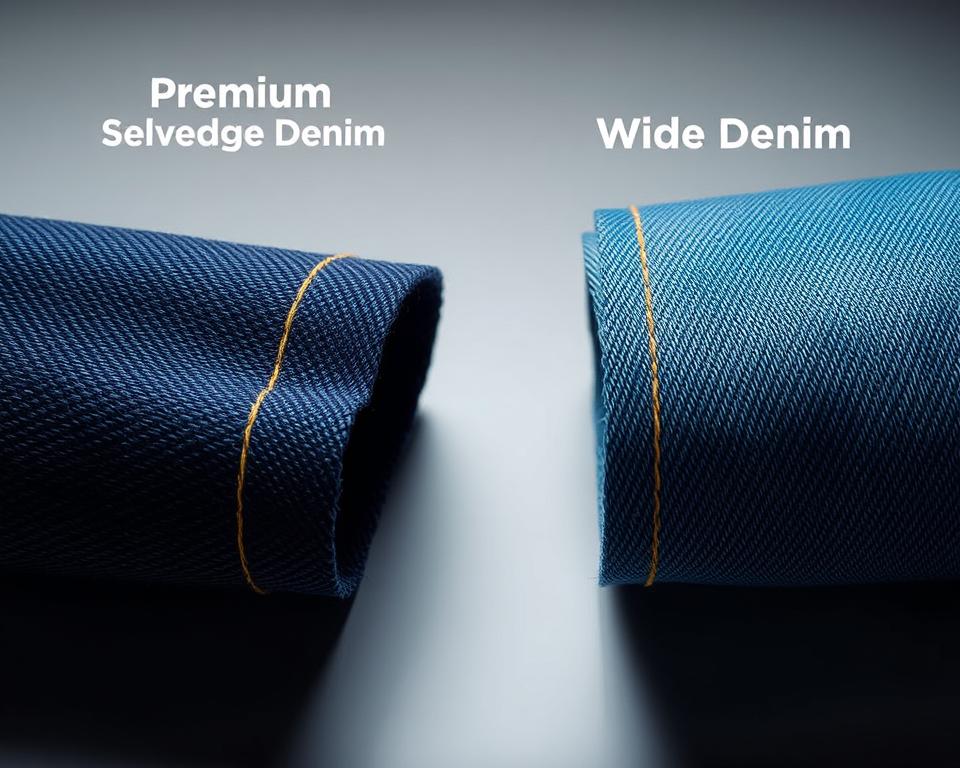The Ultimate Manual to High-Quality denim Selvedge Fabric
Ever questioned the reason some pants seem as though they are made to last the ages? It’s all about the components and artistry. Consider the increasing popularity of high-end selvedge. It’s not merely ordinary textile—it attests to superiority and heritage.
Nowadays, increasingly more individuals are opting for these classic textiles for their sturdiness and iconic ewingfly denim allure. Be it that you are a DIY sewist or a denim aficionado, there’s an exceptional aspect about employing high-quality natural fiber and stitching. It isn’t solely concerned with constructing pants; it involves producing a legacy.
At Core Fabrics, we’ve curated a selection of 14.25oz certified organic cotton and flexible choices. These fabrics are ideal for all from raw trousers to designer jacket blueprints. Eager to discover the world of premium fabrics? Let’s jump right in.
Understanding Denim Selvedge Fabric?
What is it that makes some jeans stand out with their distinctive, finished without extra steps edges? The key is found in the selvedge denim, a superior material renowned for its enduring strength and vintage charm. In contrast to standard textiles, this type of fabric is fashioned with traditional methods that have endured through ages.
The Definition of Selvedge Denim
Selvedge denim is created via old-style shuttle looms, which yield slender widths of about 30-35 inches. The looms interlace the material in a method that delivers self-finished seams, often marked by a characteristic red line. Such a process guarantees the textile is tightly woven and extremely robust.
Contemporary looms, on the other hand, produce expansive material but fall short of the same level of artistry. The imperfections in selvedge, like misaligned seams or irregular surfaces, are accepted as elements of its beauty. This philosophy, termed “wabi-sabi”, honors the aesthetic of natural flaws.
The Making of Selvedge Denim
The production of selvedge denim involves a meticulous process. These looms weave the horizontal threads in alternating directions, forming a thick and sturdy fabric. Unlike modern methods with new-age looms, which prioritize speed and efficiency over quality.
Labels such as Karson Denim maintain vintage Japanese craft practices from the nineteen-nineties. They deliberately incorporate imperfections to preserve the genuineness of the material. All products is evaluated on a 4-point system, ensuring it meets the peak requirements of quality.
| Feature | Selvedge Denim | Current Denim |
|---|---|---|
| Width | 30-35 inches | 60+ inches |
| Construction Technique | Shuttle Loom | Contemporary Loom |
| Texture | Non-uniform, Raw | Consistent |
| Durability | Exceptional | Average |
“The charm of selvedge resides in its natural irregularities—each flaw tells a story craftsmanship and tradition.”
The Background of Selvedge Denim
Evolving from simple roots to worldwide renown, the tale of these materials is rich and inspiring. Originally developed as hardwearing clothing in 17th-century France transformed into a signifier of timeless style and craftsmanship.
Historical Roots
The roots of this material reaches back to Nîmes, France, where it was known as “serge de Nîmes.” Initially created for the working class, it was crafted out of sturdy cotton and yarn. Its durability made it a favorite among laborers during the Gold Rush.
In the 20th century, it had become a essential element for pants. The closure of the Cone Mills White Oak facility served as a catalyst. This transition opened the door for Japanese artisans to reintroduce classic fabric-making practices.

Evolution in Modern Denim Production
Post-WWII, Japan embraced retro American culture. Skilled workers repaired classic looms to manufacture true reproductions. This commitment to craftsmanship secured the perseverance of selvedge as a unique product.
In modern times, innovations from Italy and Turkey have brought forth environmentally conscious mixtures and elastic options. These advancements have expanded the attraction of this everlasting textile. Here at Core Fabrics, we source globally, from Montréal to Asia, to offer you the finest standards.
“The legacy of selvedge is a celebration of the lasting worth of craftsmanship and legacy.”
Reasons to Select Selvedge Denim?
What makes selvedge denim distinguish itself in the universe of top-tier materials? Its distinct attributes and exceptional longevity render it popular among lovers and creatives alike. Be it that you are making jeans or a tailored jacket, this textile delivers a blend of heritage and modern appeal.
Unique Qualities of Selvedge Fabric
Selvedge denim is known for its tight weave, which boosts tear resistance and wear patterns. Differing from regular textiles, selvedge denim material is fashioned using classic shuttle looms, creating a tightly packed and extra robust product. In doing so, it secures that each piece has a distinct surface and character.
Key features include:
- Hairy, rigid raw denim juxtaposes against softened, pre-washed stretch fabrics.
- Sanforization stabilizes the fabric for consistent measurements, while untreated fabrics provide a unique shrinkage journey.
- Available weights span from 9.5oz Eco Finish to 14.25oz Organic, catering to diverse applications.
Robustness and Endurance
One of the most remarkable aspects of selvedge denim is its long life. The tighter weave both reinforces strength and permits characteristic wear patterns over time. This makes it a treasured choice for those seeking timeless pieces.
Key points to consider:
- 12-14oz weights are ideal for structured jackets and jeans that soften with age.
- Opt for the 14.25oz True Indigo for traditional jean lifespan.
- Green alternatives, including recycled cotton with indigo blends, contribute to a sustainable collection.
At Core Fabrics, our collection includes a variety of options to suit your needs. Spanning from raw finishes to sanforized treatments, each selection is designed for superior quality and value.
Selvedge vs. Wide Denim: A Comparison
When it comes to crafting durable and stylish garments, the choice of fabric plays a crucial role. Two common choices include selvedge and wide denim, each with unique characteristics. Understanding their differences can help you choose the ideal material for your creation.
Key Differences in Weaving Techniques
Selvedge denim is woven on time-honored shuttle looms, producing narrow widths of 30-35 inches. This selvedge denim jacket method creates firm borders, often accented with a characteristic red line. Wide denim, on the other hand, uses modern projectile looms, resulting in widths of 60 inches or more.
Traditional shuttle looms operate at approximately 3 meters per minute, while modern projectile looms reach speeds of 30 meters per minute. The variance in production speed affects both the expense and the texture of the end result.
Benefits and Drawbacks
Selvedge denim is renowned for its high-end construction and robustness. Its slender dimension renders it perfect for applications where exposed edges or decorative patches are required. However, it can be more expensive, averaging $23 per meter.
Wide denim is budget-friendly, ranging at $8 per half-meter. Its wider width reduces waste, well-suited to big-scale works like furniture covering. However, it falls short of the unique edge finish of selvedge.
| Attribute | Selvedge Denim | Wide Denim |
|---|---|---|
| Width | 30-35 inches | 60+ inches |
| Technique | Classic Shuttle Loom | Projectile Loom |
| Production Speed | 3m/min | 30m/min |
| Price | $23/meter | $8/half-meter |
For structured edges, like those needed in Grainline Thayer jackets, selvedge is the preferred choice. For larger projects, wide denim offers better value and efficiency. Evaluate your project specifications to choose wisely.
How to Use Selvedge Denim
Utilizing superior fabrics can transform your sewing endeavors. Be it making trousers, blazers, or skirts, knowing how to measure, sew, and care for the material secures expert outcomes. Let’s explore how to make the most of this classic textile.
Material Requirements for Jeans and Jackets
When planning your project, calculating the right amount of material is crucial. Men’s jeans typically require roughly 3-3.3 yards, factoring in flaws and potential shrinkage. Trucker jackets typically require 3.3 yards, while a skirt often needs 2 yards.
Smart pattern positioning minimizes the impact of defects. Instead of cutting around defects, consider integrating them into your design for a unique look.
| Garment | Fabric Needed |
|---|---|
| Jeans for Men | 3–3.3 yards |
| Trucker Jacket | 3.3 yards |
| Skirt | 2 yards |
Tips for Sewing and Care
Employing proper equipment and methods leads to an impeccable finish. Select #70 to 110 needle sizes and foot accessories designed for heavy materials. For contrast stitching, Gütermann rPET thread is a reliable choice.
Consider these extra tips:
- A tailor’s clapper helps deliver defined creases without unwanted shine.
- Our denim kits from Core Fabrics comprise topstitch thread, rivets, and 9mm jeans buttons to ensure a refined result.
- Structured edges, essential for jackets, are best achieved with selvedge.
Proper care extends the life of your creations. Wash sparingly and air dry to maintain the material’s integrity. With these tips, your projects will stand the test of time.
Wrapping It Up
Using superior fabrics goes beyond mere durability—it’s about instilling personality. Selvedge denim epitomizes this principle, fusing handcrafted appeal with robust strength. From jeans to tailored jackets, every stitch of this material conveys a narrative.
At Core Fabrics, we make it easy to explore your creativity. Our swatch service lets you touch and test the fabric before deciding. Additionally, benefit from complimentary shipping on orders exceeding $150 USD throughout North America.
Eco-friendly mixtures and classic washes are paving the way for the next generation of cotton fabrics. These trends offer new ways to add sustainability and style to your wardrobe.
Eager to explore top-tier textiles? Start shopping today to experience purposeful design. Your subsequent creation may well become an enduring classic.


